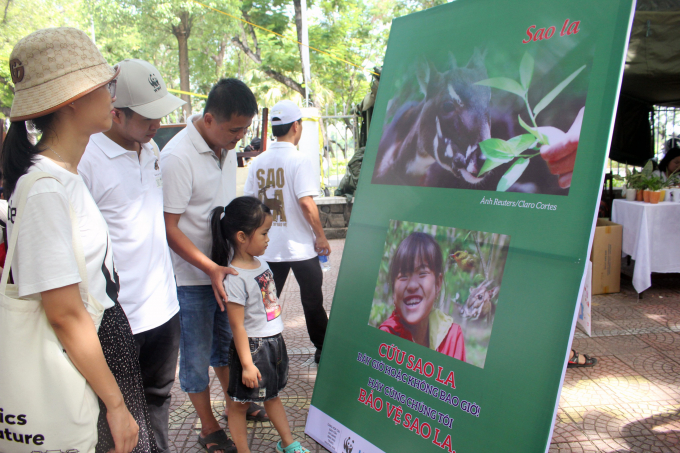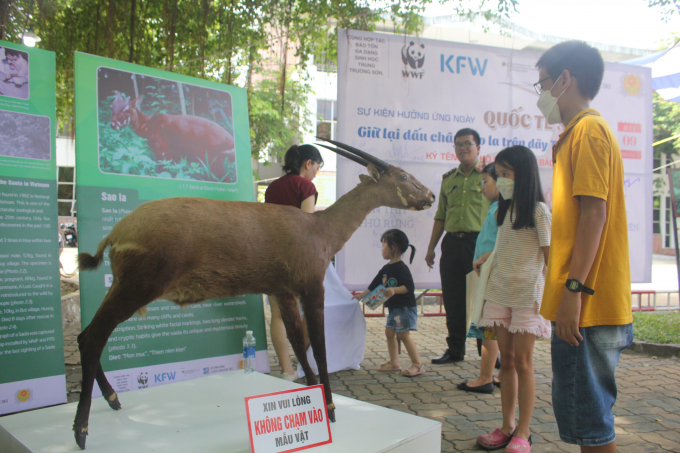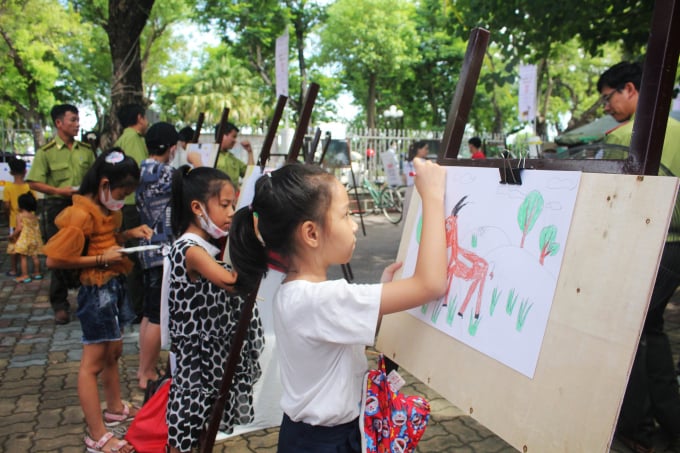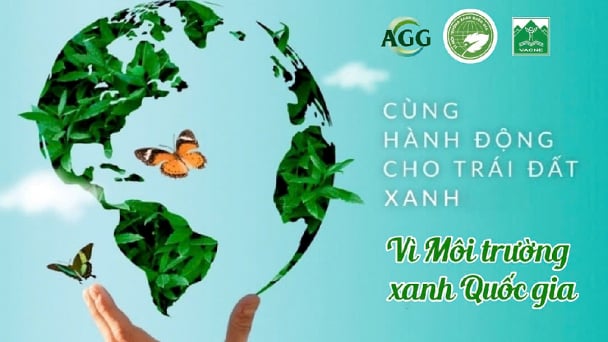May 19, 2025 | 01:50 GMT +7
May 19, 2025 | 01:50 GMT +7
Hotline: 0913.378.918
May 19, 2025 | 01:50 GMT +7
Hotline: 0913.378.918

The exhibition has attracted many local visitors. Photo: Cong Dien.
The discoveries of Saola in Thua Thien - Hue were mainly from 1995 to 1999. In 2013, scientists rediscovered Saola through photographic traps in Quang Nam province bordering Thua Thien - Hue.
Thua Thien Hue is a province with high biodiversity including a green forest in the Central Truong Son mountain range, home to various rare and precious mammal species, including Saola (Pseudoryx Nghetinhensis), also known as the Asian Unicorn. However, the social awareness and interest level in the Saola species is still very low.
Within the framework of the Carbi 2 project, the Thua Thien - Hue Department of Forest Protection in collaboration with the World Wide Fund for Nature in Vietnam (WWF-Vietnam) organized an exhibition titled "Preserving the Saola's footprints on Truong Son mountain range" to commemorate the international Saola day on July 9th. The exhibition aims to raise awareness and strengthen social participation in protecting this rare animal species - a pride of Vietnamese nature, which is facing the risk of extinction.
Many activities were organized at the exhibition such as displaying photos, posters and models, screening movies, 3D Saola models; Cycling for Saola around the city center; drawing contest and exchanging junk for souvenirs.

Saola model on display at the exhibition. Photo: Cong Dien
The saola (Pseudoryx khetinhensis) is the most mysterious ancient mammal in the world. At the time of discovery, Saola was already a rare mammal with a very small population. The Saola lives mainly in the primeval forests of Central Truong Son in Vietnam as well as the Southern Laos. In 2006, the International Union for Conservation of Nature (IUCN) recognized the status of the Saola species to be "Critically Endangered".
Saola was first discovered in Vietnam in 1992 in Vu Quang National Park, Ha Tinh, near the Vietnam-Laos border. The discovery of Saola is considered a globally significant event in the history of science as only five species of large mammals were discovered in the last 100 years. This was also one of the most important discoveries regarding animals in the 20th century.
In Thua Thien - Hue, the discoveries of Saola were mainly from 1995 to 1999. It was not until 2013 that scientists rediscovered Saola through photographic traps in Quang Nam province bordering Thua Thien - Hue.
The Saola population has been very small since its discovery. The species are distributed thinly, scatteredly, and saola mainly inhabits the upstream rocky areas at an altitude of over 200 to 600 meters. It is also impossible to determine how many individuals are left; so conservation of the species is extremely difficult.
Additionally, Saola also faces dangers from humans. The biggest threat of which is illegal poaching. While saola is not the main target of poachers, the species also become victims when they accidentally fall into traps laid by hunters to capture other wild species within the Central Truong Son area - to provide for the increasing consumption needs by a large part of the society.

The drawing contest on the theme of nature received enthusiastic participation from children. Photo: Cong Dien.
Additionally, habitat fragmentation and destruction due to unsustainable development and illegal logging is another constant threat facing Saola's survival. Vegetation-rich riverbanks, streams, rapids, and misty forests are Saola's favorite feeding areas. However, these areas are being plowed, destroyed, and narrowed by construction projects (such as hydroelectric dams) and the conversion of forest land into arable land.
In recent years, with the efforts from relevant sectors as well as the companionship of NGOs, the protection of Saola species has received strategic attention. One of the first attempts to combat these threats was the establishment of Saola Conservation Area in Thua Thien Hue. This is a necessary and urgent work. The Quang Nam Saola Conservation Area, Bach Ma National Park and Seap National Park - Laos has collaborated to form an important seamless habitat for Saola, covering over 200,000 hectares of Truong Son forest along the border of Laos and Vietnam.

The exhibition of animal traps seized by functional forces. Photo: Cong Dien.
However, despite constant efforts, poaching, trapping and other threats still occur regularly in Saola's habitat, threatening the survival of this animal in the future.
Mr. Le Ngoc Tuan, Director of Thua Thien - Hue Department of Forest Protection, said that the international Saola day was created to raise awareness and attract participation from the society to contribute to the conservation of this rare animal. Through communication activities about Saola, the people will have a better understanding of the significance of Saola.
“Most importantly, the community needs to join hands to preserve the Saola species because this is not simply a fight to protect an endangered species. This is a fight to protect mother nature, ecological interests, community livelihoods, indigenous culture and all that the saola stands for”, emphasized Mr. Tuan.
Translated by Nguyen Hai Long

(VAN) 14 out of 35 domesticated elephants in Dak Lak province have had their living conditions improved, with 11 of them currently participating in the non-riding elephant tourism model.

(VAN) Muong Nhe Nature Reserve hopes that being upgraded to a national park will lay the foundation for forest protection efforts to be carried out in a systematic, modern, and sustainable manner.
/2025/05/16/3923-2-171845_52.jpg)
(VAN) Lower costs, higher yields, and improved soil quality are outstanding benefits that soybeans bring when integrated into the crop rotation system.

(VAN) The 'For a Green National Environment' programme aims to promote a green lifestyle, support businesses in implementing ESG practices, and turn Net Zero commitments into concrete actions.

(VAN) Cold-barn systems efficiently manage environmental and temperature conditions, which aids in the prevention of respiratory diseases in pigs and protects them from the vectors that transmit African swine fevers.

(VAN) To tackle challenges, the project 'Addressing key technical bottlenecks in the grouper supply chain in Vietnam' has been underway since 2024.

(VAN) The project 'Disease-Resilient and Sustainable Cassava Production Systems in the Mekong Region', funded by the Australian Center for International Agricultural Research (ACIAR), is being implemented from 2024 to 2028.